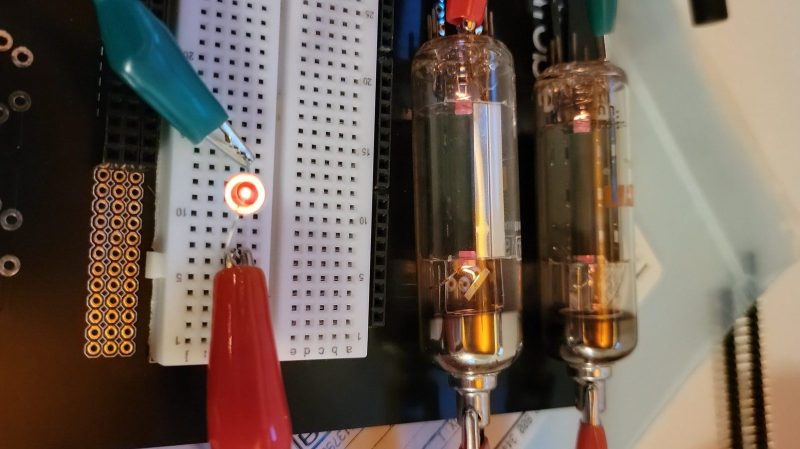Typically, if you want to convert solar energy into electrical energy, you use either photovoltaic (PV) cells, or you use the sunlight to create steam to turn a turbine. Both of these methods are well-established and used regularly in both small- and grid-scale applications. However, [Nick Poole] wanted to investigate an alternative method, using thermionic converters for solar power generation.
[Nick] has been gearing up to produce various styles of vacuum tubes, and noted that the thermionic effect that makes them work could also be used to generate electricity. They are highly inefficient and produce far less power than a photovoltaic solar cell, meaning they’re not in common use. However, as [Nick] notes, unlike PV cells etched in silicon, a thermionic converter can be built with basic glassworking tools, requiring little more than a torch, a vacuum pump, and a spot welder.
Experiments with a large lens to focus sunlight onto a 6V3A diode tube showed promise. [Nick] was able to generate half a volt, albeit at a tiny current, with the design not being optimized for thermionic conversion. Further experiments involved electrically heating a pair of diode tubes, which was able to just barely light an LED at 1.7 V and a current of 7.5 uA. The conversion efficiency was a lowly 0.00012%, around 5 orders of magnitude worse than a typical PV cell.
[Nick]’s hope is that he can produce a tube designed specifically to maximize thermionic conversion for energy generation purposes. It’s likely there is some low-hanging fruit in terms of gains to be made simply by optimizing the design for this purpose, even if the technique can’t compete with other solar generation methods.
In any case, we’re eager to see what [Nick] comes up with! We love to see makers building tubes in their own home workshops.


















I’ve always wondered if you can achieve this with car headlight assemblies … you’ve got two filaments, or possibly it can work with one good one and one burned out, as long as there is conductor exposed still. If you’ve got the sealed beam type you have a reflector built in and can point the whole thing at the sun, or use a scrap housing for regular HL bulb or stop and tail dual filament, or build a larger reflector.
I’ve made [ not so great ] diode tubes from car headlight bulbs. It sort of works. Additional tinfoil on the outside in the right place improves it a little but not a lot.
There’s also the “flame diode”. Although I’ve not experimented to see if those produce a usable amount of electricity from a light source.
It sounds like this is in a class of devices that would be easy to manufacture from local materials say on the Moon. Of course, much higher efficiency would be required before it was at all reasonable to do so.
Probably never as efficient as a PV cell but… PV cells age out. Would this?
How about in space? Would the sealed glass envelope even be necessary?
All the while a filament is glowing you’re boiling away a tiny bit of metal off it, which also plates the inside of the envelope slowly, so yeah, wearing out will be a thing.
I don’t think he’s using the filament. It does kind of look like the orange glow of a filament in the static picture at the top but I think that’s just reflection from the LED. Look at the tube in the video, the only light I see there is the white light he is aiming at it reflecting off the glass.
If he does need to heat the filaments to make this work then I don’t see how he could ever hope to even break even let alone produce more power than he is consuming.
Oh, and back to it being hard to tell due to light from outside reflecting off the glass envelope. I think I see an area that needs optimization there! Too much light is reflected away.
Well either the sun is making them hot enough to thermionically emit, thermionic meaning it depends on heat, or the filament to copper bond is acting like a thermocouple and he’s measuring that without getting them hot enough… but yeah, intense solar gain, limited convective transfer (in vacuo) should mean they get at least infra-red glowy, but the more glowy, the more output.
So source of heat don’t matter, electrical, solar, liquid sodium pumped down a hollow emitter from your atomic boyscout pile…. a bit of metal gonna blow off with it. Tiny amounts but cumulative. Can take a lonnnnng time, like that 100+ year old firestation lightbulb… which is quite underrun in terms of emission for input.
No doubt these don’t fair well with highly energetic particles flying around.
Why not try and make Photocells, the two electrode vacuum tube light sensitive devices that used to be used in old film projectors to read the optical soundtrack in the days before silicone photodiodes.
These probably fare very well in high radiation Flux like space. I wonder if a tube like this could be used in the center of a solar thermal array.
At that efficiency…Plant corn and build a still.
You should check out this paper they are up to 40% thermal to electrical power conversion….
https://www.nature.com/articles/s41586-022-04473-y
You can’t drink electricity!